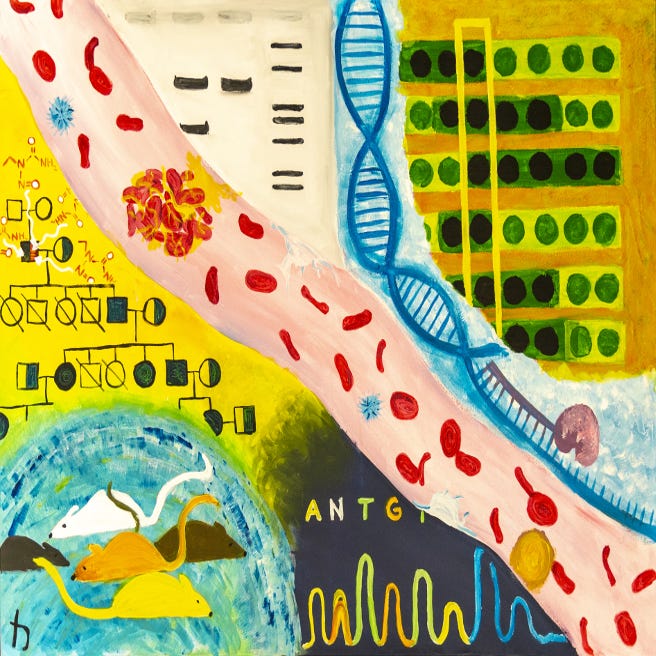#15: The Art of the Matter
Reflections on the value of art in how we see and understand science.
I am never not fascinated with the alchemy that is the artistic expression of science.1
The creation of something beautiful out of the ordinary - say, the dry pages of a textbook relaying key concepts, or a final report of research results, stuffed with numbers and decorated with the detached language of the scientific observer - is endlessly fascinating to me.
But alchemy isn’t about creating something beautiful, but something valuable. And in that regard, as I see beautiful examples of embroidery of DNA and anatomy, a painting of a genetic screen of a fatal blood clotting disease, and even the periodic table in cupcake form, I wonder about the value in art in science.

When I say value, I mean to say, is there importance to the creation, beyond being pleasing to the eye? Is it important that we use art in science? And I think that, yes, it can be used in important ways that add value and improve our understanding of the world around us.
How is Art Used in Science?
Art as Data Collection Tool
The more obvious examples are those where art is a means of generating research data. Uses of art as a methodology are found in qualitative studies (e.g., interviews with a sample of people on their experiences and understanding of a topic) or mixed methods studies (e.g., combining those interviews with questionnaires that provides numerical data that can be used to make predictions about the larger population). In these studies, art can provide a jumping off point for a participant to explain their thoughts, experiences and emotions visually. The use of photovoice is an especially great example of an art-based data collection method. Your participants take pictures of their experiences with a concept, so you as researcher can see it through their eyes. It can help the participants initially put to words what may be otherwise difficult to express, and is a great tool of empowerment when working with underserved or marginalized populations.
Here’s one such study, which used using photovoice to examine the experiences of health and well-being of First Nations, Métis, and Inuit students in Edmonton schools.
Or, the art can be created by a researcher to then inform more data collection and interpretation. Take the work of Dr. Mark Gilbert, who did a residency here in Saint John and collaborated with pediatric neurologist Dr. Wendy Stewart to capture experiences of youth living with epilepsy.
In these cases, like the genetics painting earlier, the art itself is a tool to create, collect and/or communicate data in an approachable way.
Art as Educational Tool
We can also look at the use of art as a pathway to teaching others about science. This is where the various art works, crafts, models, and baked goods are. While one could argue that these are to be enjoyed in their own right, as art objects of perhaps a quirky subject (and not a traditional pose or still life), they too invite us to look more closely at a concept, even if briefly.

Sometimes these are created as a lark. Other times, it’s a hobby that evolves into something more. Nobu Tamura is a physicist who has illustrated over 1,500 pictures of prehistoric creatures based on reading the literature for new data and anatomical descriptions of dinosaurs, fish and creepy crawlies. Starting as an evening pastime, he’s now the main provider of accurate dinosaur images for all those Wikipedia pages.
The Art of the Matter: Making Connections Within Us, Between Us.
Through all of these examples, and more, I’ve come to realize that the value of art in science is that it provides a conduit to deeper understanding.
The procedures and techniques adopted by scientists and artists may be very different. Ultimately, however, they both have a common aim. Artists and scientists both want to 1) make sense of the vastness around them in new ways, and 2) present and communicate it to others through their own vision.
Emmi Khan, Moleculart
Whether the scientific message is large or small, the message is enhanced because it provided an extra channel of communication. At its core, art provokes new thought and stimulates deeper connections.
What especially excites me is that these connections may not just be between concepts, as the art leads you down a new line of thinking, but between people2. The art brings us together on a common ground free of scientific jargon to share our individual thoughts, and maybe even seed the beginnings of a new relationship.
And how valuable is that?
What do you think about the role of art in science? Leave your thoughts in the comments below.
~ Bryn
Thanks for reading! If you liked this post, please consider sharing it, and subscribing to receive more posts directly to your email as they are published.
Like I hope my sharing these examples on my Twitter and this newsletter continue to do? 👉🏻👈🏻🥺








Once again your meme and graphics skills are supreme.
This: "At its core, art provokes new thought and stimulates deeper connections... What especially excites me is that these connections may not just be between concepts, as the art leads you down a new line of thinking, but between people."
Amen.
Wow, this is deeply fascinating, Bryn - and the whole concept of art bringing us together regardless of context is something that I hadn't much thought about. Thank you so much for a brilliant read.
Oh, and how about those cupcakes?! 😍